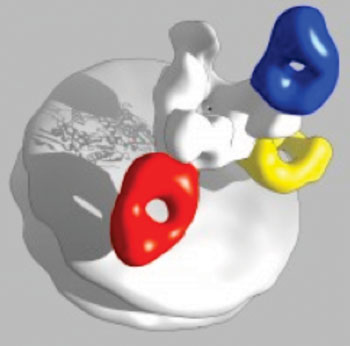Electron Microscope Imaging Shows How Experimental Anti-Ebola Drug Works
By LabMedica International staff writers
Posted on 27 Nov 2014
Electron microscope imaging has revealed how the experimental drug ZMapp binds to the Ebolavirus and provides insights into how the drug prevents growth of the pathogen.Posted on 27 Nov 2014
ZMapp, which was developed by Mapp Biopharmaceutical (San Diego, CA, USA), comprises three monoclonal antibodies (mAbs) that have been chimerized by genetic engineering. The components are chimeric monoclonal antibody c13C6 from a previously existing antibody cocktail called MB-003 and two chimeric mAbs from a different antibody cocktail called ZMab, c2G4 and c4G7.

Image: A 3-dimensional picture reveals how the antibodies in the experimental drug Zmapp bind to Ebola virus (Photo courtesy of the Scripps Research Institute).
Investigators at The Scripps Research Institute (La Jolla, CA, USA) reported in the November 17, 2014, online edition of the journal Proceedings of the National Academy of Sciences of the United States of America (PNAS) that two of the ZMapp antibodies bound near the base of virus, appearing to prevent the virus from entering cells. A third antibody bound near the top of the virus, possibly acting as a signal to the body’s immune system to attract defensive immune cells to the site of infection.
The investigators also found that two of ZMapp's components recognized overlapping epitopes and competed with each other for binding. “This information helps guide decisions about how to formulate these life-saving therapies,” said first author C. Daniel Murin, a graduate research student at The Scripps Research Institute. “Instead of including two different antibodies that do the same thing, why not use twice as much of the more effective one instead? Or include a third antibody against a different site to stop the virus a third way?”
Related Links:
The Scripps Research Institute
Mapp Biopharmaceutical













